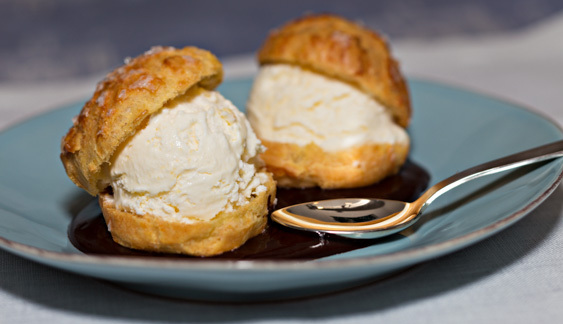Profiteroles

introduction
Profiteroles are baby cream puffs made from choux paste. As if life weren’t great enough for them, profiteroles are also favored with soft, yielding fillings—ice cream, whipped cream, pastry cream—and usually a chocolate sauce. Their petite stature and unambiguous sexiness makes profiteroles irresistible to most any mere mortal.
But profiteroles are deceptive: they can look pretty when they are underbaked and squishy and when overbaked and hard—and yes, even if they’ve been frozen, thawed, and filled. Bulbous and misshapen profiteroles often still get a pass because the people eating them become so intoxicated at the sight of ice cream and chocolate sauce in the arms of a profiterole that they forget about the pastry itself.
You will not forget the pastry when you make this recipe.
We offer our profiteroles an incandescent frozen filling—somewhat akin to a whipped semifreddo—and sauce options that are sublime. But remember, it’s the pastry that makes the ensemble really lovely. So please, bake the little puffs and serve them same day, when they are crisp and creamy and bring forward their best game. Otherwise just buy some cookies.
Baking Notes
We cannot emphasize enough the care that must be taken with this delicate, world-class pastry. Crisp the profiteroles slightly in a low (250-degree) oven before serving if the day has been humid, but don’t leave them to dry into fried insects and then expect them to have any impact as a pastry. Don’t freeze, reheat, and serve. Have a little respect, for Pete’s sake!
King Arthur Flour now offers sparkly sanding sugar! (They call it “sparkling white sugar.”) Not only does it taste crunchy and look good on the profiteroles, it improves the structural finish of the pastry.
equipment mise en place
For this recipe, you will need a heavy baking sheet, parchment paper, a large (at least 14-inch) pastry bag, a plain round pastry tip ⅝ inch (17 mm) in diameter, a tall drinking glass (to support the pastry bag as you fill it), a metal spatula, a chopstick or wooden skewer, a small serrated knife, a fine-mesh strainer (if using confectioners’ sugar), a spoon or small ladle, and an ice-cream scoop.
-
-
1recipe Pâte à Choux
-
Sanding sugar for sprinkling (optional)
-
Confectioners’ sugar for dusting (if you do not use sanding sugar)
-
1recipe Chantilly Meringue
-
1recipe Strawberry Syrup or warm Hot Fudge Sauce
-
-
Adjust the oven rack to the middle position and heat the oven to 425 degrees. Line a heavy baking sheet with parchment paper. Fit a large (at least 14-inch) pastry bag with a ⅝-inch (17-mm) plain round tip. Twist the bag just above the tip (fig. 1.1) and push it into the tip to prevent the paste from dribbling out when you load the bag. Fold over the open end to form a cuff and hold the bag under the cuff with one hand.vLoad the choux paste into the pastry bag with a rubber spatula (fig. 1.2). When scraping out the bowl with just one hand becomes cumbersome, set the bag tip-side down in a tall drinking glass; the glass will support the bag as you continue to fill it. Unfold the cuff, lay the bag on its side, and use a small metal spatula to scrape the paste toward the tip of the bag (fig. 1.3).
-
Use small dabs of choux paste left in the bowl or on the spatula to glue the corners of the parchment paper to the baking sheet. Gather up and twist the wide end of the bag, unwind the knot from the tip end, and pipe twenty-four 2-inch rounds of paste in six rows of four. Try to pipe the mounds high and round (fig. 2.1). Sprinkle each mound with about ½ teaspoon of sanding sugar, if using (fig. 2.2).
-
Bake for 15 minutes, until the mounds have puffed impressively and colored lightly; do not open the oven door during this time. Lower the oven temperature to 350 degrees and continue baking until the puffs are deep golden, about 20 minutes more. Remove the baking sheet from the oven (close the oven door) and quickly pierce the side of each profiterole with a chopstick or wooden skewer to allow steam to escape (fig. 3.1); handle the pastries gently, as they are quite delicate. Return the baking sheet to the oven, turn off the oven, and prop open the door with the handle of a wooden spoon. Allow the profiteroles to dry in the vented oven for 10 minutes, and then close the oven door completely and let dry for 1½ hours (fig. 3.2). In low humidity conditions, the puffs can be held for up to 4 hours at room temperature before serving.
-
Using a small serrated knife, carefully cut in half along the equator as many profiteroles as you’d like (two per person is a good baseline). If using confectioners’ sugar, set the lids on the baking sheet and use a fine-mesh strainer to sift confectioners’ sugar over them. Spoon or ladle Strawberry Syrup or Hot Fudge Sauce onto individual serving plates and place the pastry bottoms on top of the sauce. Scoop Chantilly meringue onto the pastry bottoms, replace the tops, and serve.
-
-
1.1

-
1.2

-
1.3

-
-
-
2.1

-
2.2

-
-
-
3.1

-
3.2

-
Step photographs by Carol Dragon